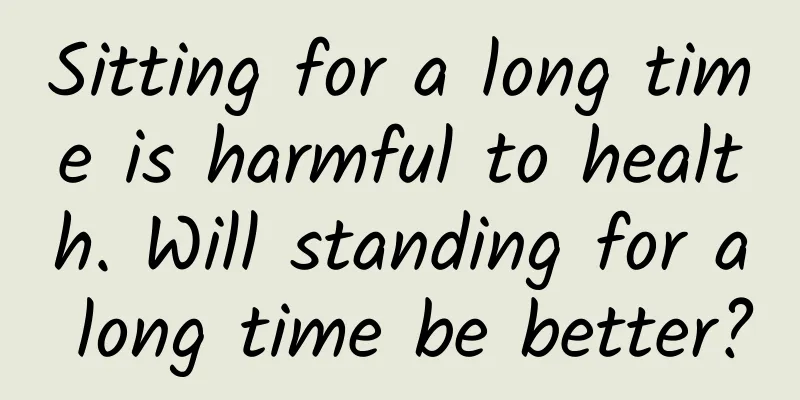Sitting for a long time is harmful to health. Will standing for a long time be better?

|
If you usually pay attention to health-related information, you may have more or less known about some of the health risks of sitting for a long time. 1. Sitting for a long time is a health killer Whether it is due to work or study pressure, or the need for entertainment or rest, people in modern society have become accustomed to long periods of sitting, whether it is due to work or study pressure, or the need for entertainment or rest. However, a large number of studies have confirmed that long periods of sitting are a well-deserved health killer. First, long-term sitting means maintaining a relatively fixed posture for a long time, which can cause muscle stiffness, fatigue, and pain in the shoulders, neck, waist, hips, knees, and other parts of the body, and can also affect the joints [1,2]. A study involving 114,829 people found that compared with recreational runners, sedentary people had a higher risk of hip and knee arthritis, which was three times that of recreational runners [3]. Secondly, prolonged sitting can increase the risk of obesity and is associated with an increased risk of chronic diseases in multiple systems, such as diabetes, cardiovascular disease, and gastrointestinal disease. Prolonged sitting can also harm mental health, reduce cognitive function, and increase the risk of all-cause mortality. For this reason, authoritative journals such as the Journal of the American College of Cardiology, Circulation, and the British Medical Journal have published reminders from associations or health departments about the dangers of prolonged sitting and calls to reduce prolonged sitting [4-8]. In addition, studies have found that diseases such as periodontal disease and childhood asthma, which at first glance seem to have nothing to do with long-term sitting, can also increase the risk of developing them due to long-term sitting [9,10]. Of course, even if they cannot fully understand these medical studies, many people are not unaware of the harm of long-term sitting to their health. However, they are either forced to work or study for long periods of time due to pressure, or they feel that their bodies are already exhausted when they take time out from their busy work and study. Even if they know that long-term sitting is not good for their health, they don’t care much. 2. Can standing desk solve the problem of sitting for long periods of time? So, is there any way to offset the health damage caused by long-term sitting? Some people think: Since sitting for a long time is not good, why not stand to work? Therefore, many people with strong execution ability began to adhere to the principle of "never sit when you can stand" in their daily work. The market has also developed various stands and desks that are convenient for standing work in response to the demand for standing work. Although it costs money and people are more tired than sitting, but when you think of the potential health benefits, do you still think that these efforts are worth it...? Unfortunately, the truth is a bit cruel. A study recently published in the International Journal of Epidemiology may pour cold water on those who have been working hard to stick to standing desks. The study included 83,013 British adults to examine the association between their sitting and standing time and the incidence of major cardiovascular diseases (coronary heart disease, stroke, and heart failure), as well as orthostatic circulatory diseases (orthostatic hypotension, varicose veins, chronic venous insufficiency, and venous ulcers). The results showed that both long-term sitting (more than 10 hours a day) and long-term standing (more than 2 hours a day) were directly associated with an increased risk of orthostatic circulatory diseases; standing was not associated with the risk of major cardiovascular diseases. In other words, standing alone may not be enough to reduce the risk of cardiovascular disease, and standing for just more than 2 hours may lead to a higher risk of orthostatic circulatory diseases. This means that standing for a long time not only cannot offset the health risks of sitting for a long time, but it may also pose health risks in itself. It is neither standing nor sitting, so is there any way to offset the harm of sitting for a long time? 3. It’s effective to offset the health risks of sitting for a long time The most effective way, of course, is to simply stop sitting for long periods of time. Instead, get up and move around for ten minutes every hour to interrupt the sedentary pattern and prevent the harm it causes. However, many people may not have the conditions to do so. Some people don't even have the luxury of going to the bathroom, let alone getting up and moving around to avoid sitting for too long. Don't be discouraged, if you can't sit for too long, you can make up for it through exercise. A prospective cohort study published in the Journal of the American Medical Association that included nearly 12,000 participants aged 50 years and older found that for people who were sedentary and largely inactive, if they engaged in more than 22 minutes of moderate to vigorous physical activity per day, the association between prolonged sitting time and risk of death could be offset [11]. A study of 73,729 adults in the United Kingdom also found that any intensity of physical activity attenuated the harmful association between sedentary time and mortality. Overall, a median of at least 6 minutes of vigorous physical activity per day, 30 minutes of moderate to vigorous physical activity per day, 64 minutes of moderate physical activity per day, or 163 minutes of light physical activity per day (adjusted for other intensities) attenuated the association between sedentary time and mortality [12]. The World Health Organization recommends that all adults should engage in 150 to 300 minutes of moderate-intensity or 75 to 150 minutes of vigorous-intensity aerobic activity per week, or a combination of moderate and high-intensity activity. Children and adolescents are recommended to engage in an average of 60 minutes of moderate to vigorous-intensity aerobic activity per day. In addition, people of all ages are advised to regularly engage in muscle-strengthening activities and minimize sedentary behavior[13]. If the amount of exercise reaches the recommended amount, it is actually enough to offset the harm caused by long periods of sitting. The intensity of exercise can be determined by referring to the heart rate during exercise. Our current maximum heart rate is roughly equal to 220 minus our age (in years). According to the American Heart Association's recommendation, the target heart rate during moderate-intensity activity is about 50-70% of the maximum heart rate, and the target heart rate during vigorous exercise is about 70-85% of the maximum heart rate[14]. By calculating the heart rate values corresponding to the two intervals, we can roughly determine the intensity of exercise we are in during exercise. Therefore, although standing for a long time cannot solve the health problems of sitting for a long time, as long as we take time to exercise after sitting for a long time every day, we can partially or even completely offset the health hazards caused by sitting for a long time. If you don’t have enough time, increase the intensity of exercise. If you are not in good physical condition, accumulate exercise time in a medium-to-low-intensity exercise mode. As long as you move, you will be much healthier than not moving. References: [1] Dzakpasu FQS, Carver A, Brakenridge CJ, et al. Musculoskeletal pain and sedentary behavior in occupational and non-occupational settings: a systematic review with meta-analysis. Int J Behav Nutr Phys Act. 2021;18(1):159. Published 2021 Dec 13. doi:10.1186/s12966-021-01191-y [2] Citko A, Górski S, Marcinowicz L, Górska A. Sedentary Lifestyle and Nonspecific Low Back Pain in Medical Personnel in North-East Poland. Biomed Res Int. 2018;2018:1965807. Published 2018 Sep 9. doi:10.1155/2018/1965807 [3] Running and Osteoarthritis: Does Recreational or Competitive Running Increase the Risk?. J Orthop Sports Phys Ther. 2017;47(6):391. doi:10.2519/jospt.2017.0505 [4] Stamatakis E, Gale J, Bauman A, Ekelund U, Hamer M, Ding D. Sitting Time, Physical Activity, and Risk of Mortality in Adults [published correction appears in J Am Coll Cardiol. 2019 Jun 4;73(21):2789. doi: 10.1016/j.jacc.2019.04.012]. J Am Coll Cardiol. 2019;73(16):2062-2072. doi:10.1016/j.jacc.2019.02.031 [5] Chen J, Ruan [6] Barnett TA, Kelly AS, Young DR, et al. Sedentary Behaviors in Today's Youth: Approaches to the Prevention and Management of Childhood Obesity: A Scientific Statement From the American Heart Association. Circulation. 2018;138(11):e142-e159. doi:10.1161/CIR.0000000000000591 [7] Yang Z, Hotterbeex P, Marent PJ, Cerin E, Thomis M, van Uffelen J. Physical activity, sedentary behavior, and cognitive function among older adults: A bibliometric analysis from 2004 to 2024. Ageing Res Rev. 2024;97:102283. doi:10.1016/j.arr.2024.102283 [8] Iacobucci G. Sedentary lifestyle is putting middle aged health at risk, PHE warns. BMJ. 2017;358:j3995. Published 2017 Aug 24. doi:10.1136/bmj.j3995 [9] Almohamad M, Krall Kaye E, Mofleh D, Spartano NL. The association of sedentary behavior and physical activity with periodontal disease in NHANES 2011-2012. J Clin Periodontol. 2022;49(8):758-767. doi:10.1111/jcpe.13669 [10] Konstantaki E, Priftis KN, Antonogeorgos G, Papoutsakis C, Drakouli M, Matziou V. The association of sedentary lifestyle with childhood asthma. The role of nurse as educator. Allergol Immunopathol (Madr). 2014;42(6):609-615. doi:10.1016/j.aller.2013.05.008 [11] Harris E. Daily Exercise May Offset Otherwise Sedentary Lifestyle. JAMA. 2023;330(20):1945. doi:10.1001/jama.2023.21871 [12] Rezende LFM, Ahmadi M, Ferrari G, et al. Device-measured sedentary time and intensity-specific physical activity in relation to all-cause and cardiovascular disease mortality: the UK Biobank cohort study. Int J Behav Nutr Phys Act. 2024;21(1):68. Published 2024 Jul 3. doi:10.1186/s12966-024-01615-5 [13] Bull FC, Al-Ansari SS, Biddle S, et al. World Health Organization 2020 guidelines on physical activity and sedentary behavior. Br J Sports Med. 2020;54(24):1451-1462. doi:10.1136/bjsports-2020-102955 [14] https://www.heart.org/en/healthy-living/fitness/fitness-basics/target-heart-rates The article is produced by Science Popularization China-Creation Cultivation Program. Please indicate the source when reprinting. Author: Doctor Flying Knife Cutting Rain Reviewer: Tang Qin, Director of the Science Popularization Department of the Chinese Medical Association |
<<: Collect suggestions and don’t be a person with “hemorrhoids”!
>>: Can you breathe in through your nose and out through your mouth at the same time?
Recommend
The pregnancy test stick is lighter today than yesterday
If a woman's menstruation is a few days late,...
When is the ovulation period on the 28th day of menstruation?
Some women have relatively normal menstruation du...
No menstruation, black discharge
The reasons why women have gray-black secretions ...
What medicine is good for vulvar dystrophy
Vulvar malnutrition is relatively stubborn and th...
Can I eat konjac during menstruation?
Women need to pay close attention to their diet d...
What is the four-dimensional examination for pregnant women?
When a woman is pregnant, it is the best time in ...
Sexual enhancement methods for women
Sexual life can be said to be the most sensitive ...
What is the common method of making sweet and sour spareribs? Do you use rock sugar or white sugar in sweet and sour spareribs?
Sweet and sour spare ribs is a representative tra...
[Health Science] Do a good job of breast screening and protect breast health
1. Why do we need breast cancer screening? Breast...
How to prepare for pregnancy?
Keeping your body in good condition before gettin...
Why can't the gas water heater ignite in winter? Is it a big deal if the gas water heater is flooded?
If the gas water heater fails to ignite in winter...
Why do women have itchy lower body?
Women are naturally more delicate and more shy, s...
Can I have intravenous drip in early pregnancy?
With the change of seasons, more and more patient...
Is it good to sprinkle wood ash on garlic? When is the best time to sprinkle wood ash on garlic?
Someone asked if you can sprinkle wood ash on gar...









